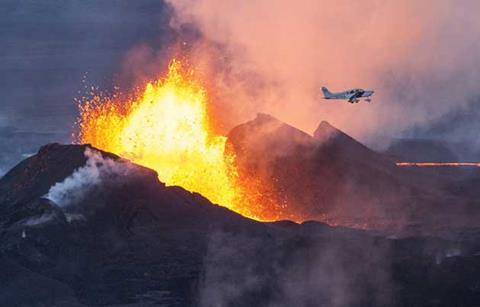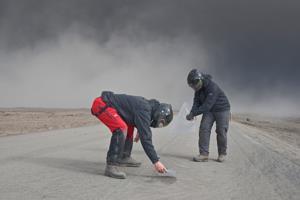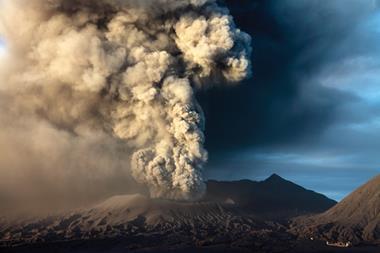Nina Notman learns the role chemistry plays in monitoring volcanoes and understanding the impact of their eruptions

As an undergraduate student with wanderlust, I found myself one summer morning walking up Pacaya volcano, the most active volcano in Guatemala. We climbed through knee-deep volcanic ash to reach the rim of the volcano’s crater where we peered down into the magnificent lava pool below. It was incredibly hot standing there, the stench of sulfur was overwhelming and my little sister was loudly questioning the safety of my chosen activity for the day, but regardless my love affair with volcanoes had begun.
And I’m not alone. Millions of people visit active and dormant volcanoes each year, and the ability to make a living through tourism is one of the top reasons people chose to live in the shadow of one of these beautiful beasts. Other draws include an abundance of metallic minerals for mining and fertile soils for farming.
But, of course, volcanoes are as temperamental as they are beautiful. And the gas, ash, lava and mudslides resulting from their eruptions have been causing death and destruction throughout history. From Mount Vesuvius in AD79 burying thousands of people around Pompeii in a blanket of volcanic ash; to the gigantic 1815 eruption of Mount Tambora in Indonesia directly killing over 10,000 people (see Sulfate aerosols and the summar that wasn’t); to Mount Sinabung in Indonesia whose ash and gas killed more than a dozen people in 2014 and at least seven more in May 2016.
A 2015 UN-commissioned report – Global volcanic hazards and risk – found that over 29.3 million people around the world live within 10km of a volcano that has been active at some point in the past 11,700 years. More than 8.6 million of these are in Indonesia, a country with around 130 currently active volcanoes.
But, living in close vicinity to a volcano that may erupt doesn’t have to be inherently hazardous in today’s world. ‘You can detect an escalation of unrest for weeks and even months in advance of a volcanic eruption,’ explains Sue Loughlin, head of volcanology at the British Geological Survey. Evacuation plans should therefore be able to be made far in advance – even though the precise timing of an imminent eruption can’t yet be predicted accurately.
Unfortunately, only a few hundred of the world’s approximately 1300 potentially active volcanoes are routinely monitored. ‘It’s the cost,’ explains Loughlin. ‘You need people to maintain the equipment once you’ve put it out and there needs to be an agency with a mandate to act upon the analysis of monitoring equipment. All of this requires commitment and governance structures and so on, so it’s not achievable everywhere. Also because volcanoes tend to erupt very infrequently, for governments it tends to not be high on the priority list, and tragically most of the big and disastrous eruptions tend to occur at the volcanoes that haven’t erupted for a long time.’
Gas monitoring
The US island of Hawaii is made up of five volcanoes, three of which are active. ‘Kilauea, Mauna Loa, and Hualalai volcanoes are the ones that we monitor,’ explains Jeff Sutton, a gas geochemist at the US Geological Survey’s Hawaiian Volcano Observatory. Kilauea is the most active, having been in continuous eruption since 1983. The last Mauna Loa eruption was in 1984, and the most recent eruption at Hualalai ended in 1801.

Most volcano observatories use four different approaches to monitor volcanic activity: observing chemical changes in the gas and magma they produce; measuring earthquake activity due to magma moving beneath the surface; mapping the nature and extent of lava flows on the surface; and studying subtle ground surface changes that occur as magma rises towards the surface. ‘No single one of these is a magic bullet for detecting when a volcanic eruption is imminent. It’s a little bit analogous to diagnosing a human patient; you check a number of vital signs: temperature, heart rate, breathing and the like before making a prognosis,’ Sutton says.
The amount and types of gases being emitted by a volcano give scientists a good understanding of any magma movement deep inside it. When magma is deep, say 60 or 80 miles below the Earth’s surface, it is under intense pressure so a lot of gases stay dissolved within it, explains Sutton. ‘When that magma comes up closer to the surface the pressure that’s been on top of it is reduced and those dissolved gases can start boiling out of the melt.’ Put simplistically, an increase in gas coming out of a volcano indicates magma is moving up towards the Earth’s surface.
‘The philosophy of volcano gas monitoring is that you make routine measurements and establish your background data, and then you are looking at deviations from that typical level,’ explains Brad Scott, a volcanologist at GNS Science, the company that oversees monitoring of New Zealand’s 12 active volcanoes.
Gas monitoring comes in lots of different guises, but a standard approach is to use UV spectrometry to remotely monitor sulfur dioxide volumes being emitted. This is the easiest of the three main volcanic gases to measure, the others being carbon dioxide and water, as it isn’t naturally present in the atmosphere.
Different gases all have different solubilities in magma
Jeff Sutton
‘We use a small UV spectrometer that’s tuned to the wavelengths of light energy that are absorbed by sulfur dioxide,’ Sutton explains. ‘We stick this on the roof of a vehicle and then drive underneath and through the gas plume that is boiling out of the melt.’ This is done on average of once a week. The instrument can also be strapped to a helicopter and flown beneath the plume, if land access is problematic.
‘In recent years we’ve also installed a network of these small spectrometers in a place that’s normally downwind of Kilauea volcano’s erupting summit vent,’ says Sutton. ‘The 10 spectrometers are strung out across and orthogonal to the plume trajectory. As the plume blows across them they measure the amount of sulfur dioxide above them. We use these data to reconstruct the plume cross-sectional gas concentrations. We acquire data from those instruments from about 8.30am until 5pm every day.’
New Zealand has a very similar set up for monitoring its gas-producing volcanoes, says Scott. But rather than a helicopter, they have a specially adapted aeroplane packed with gas measuring equipment. And it’s not just sulfur dioxide they are looking for when airborne. By looking closely at other species of volcanic gases and also the ratios between them, much more information than just whether or not magma is moving can be determined. ‘The gases all have different, varying solubilities in the melt; that really helps us discern what might be going on at depth,’ Sutton says. For this, FT–IR spectrometry is the favoured remote monitoring technique. Scott’s team also do direct gas monitoring, collecting samples from high-temperature fumaroles (or vents) for chromatographic analysis back at the lab.
On the highly volcanic island of Iceland, gas monitoring is also used to observe volcanoes that are not producing gas plumes. ‘One of the projects we’re doing at the moment is monitoring carbon dioxide emitted from soil around Hekla Volcano. That’s a volcano that everybody’s anticipating will erupt soon,’ says Loughlin. The British Geological Survey supports the Icelandic Meteorological Office with its monitoring activities on more than 30 volcanoes. ‘The carbon dioxide is emitted diffusely across quite a broad area so you can detect it just coming up through the ground. The other place you can detect it and other gases is in ground water, so we’re also monitoring ground water and again it’s about looking for change which might give us clues about when Hekla is switching into an unrest phase before an eruption.’
Magma chemistry
Another way to get clues as to what is going on deep inside a volcano is to look directly at the chemical makeup of its magma. This can be done by scooping up some lava, magma which has escaped the volcano and is typically over 1000°C, coming from an active volcano or by studying the volcanic rocks (cooled magma).

‘Magma is molten rock and it also contains dissolved gases and crystals,’ explains Kate Saunders, a volcanologist specialising in magma chemistry at the University of Edinburgh in the UK. Magma and the crystals within it have different chemical signatures that can be used to indicate at what depth it formed and the conditions it has been subjected to as it rises to the surface. ‘Magma get modified as they rise toward the surface. There are a lot of processes that can occur to them, for example crystals can grow, magma can melt the surrounding rocks and then that material is incorporated into the magma. If we look at the chemistry of the magma, and the different components of the magma, we can start to work out what processes have occurred and understand what is happening in the Earth’s crust,’ says Saunders. In practice, this means measuring the low concentrations of metals and the rare earth elements within the magma.
A really silica-rich magma can hold a lot more water in it
Kate Saunders
Saunders’ research focus is analysing volcanic rocks to find the chemical footprint of past volcanic eruptions, with the ultimate aim for aiding future volcanic eruption predictions. It is fairly typical, for example, for a volcano to go into a state of unrest and then just fall back asleep again. To avoid needless evacuations, or worse apathy towards warning signs, a better understanding of a volcano’s historic behaviour pattern will enable volcanologists to better predict how it might behave today.
Saunders is currently probing the secrets of the approximately 16 volcanoes on the Indonesian island of Sumatra; this includes the one responsible for the fatal eruption of May 2016. ‘Mount Sinabung has been erupting frequently for the past few years. This is a volcano that Indonesia classified as being dormant, having not shown signs of eruptions for the past 400 years or so,’ she says. ‘Then it suddenly started to erupt. There was no monitoring or background on that volcano. Having gone into the geological records, we can start to see what has happened previously and how that might be useful for future eruption predictions.’
Studying rock to get an insight of the chemistry of the magma inside a volcano can also help predict what type of eruption there will be if there is one. The style of the volcanic eruption tends to depend on how much dissolved gas is in the magma and this in turn depends on its chemical composition. ‘A really silica-rich magma can hold a lot more water in it, for example, than an iron- or magnesium-rich magma,’ Saunders explains.
‘If we have a magma with little dissolved gases it tends to erupt quite passively – you get lava flows. What’s really problematic is when we’ve got lots of dissolved gases that are held under pressure because they are underground. If the pressure is suddenly removed, you suddenly get this big, really explosive eruption, and the more gases you’ve got in there, the more explosive.’ Ash is also produced when an otherwise passive eruption explodes through a glacier, due to its water content.
Ashes to ashes
During the explosion the force of the escaping gas shatters the magma and propels it into the atmosphere. Here it solidifies into fragments known collectively as volcanic ash. And while studying the composition of ash can also offer insight into the inner workings of a volcano, it is more often probed to see what its possible affects are on agriculture, water, human health and aircraft.

The soil around volcanoes is typically extremely fertile; volcanic ash breaks down rapidly to release nutrients such as iron and magnesium. ‘When the ash hits the ocean, it can bring very important nutrients to the surface layers of the oceans,’ explains Sigurdur Gíslason, a volcanic ash expert from the University of Iceland. Iron for example promotes production of an enzyme for nitrogen-fixing bacteria and it can boost biological growth in the ocean.
But it’s not all good news. A common concern is that the mineralogical composition, including the crystalline silica content, and fine grained nature of ash may harm the respiratory systems of people living nearby. And perhaps the best known negative effect of volcanic ash is on air traffic. The eruption of the Icelandic Eyjafjallajökull volcano in 2010 closed airspace across Europe for around seven days. And while that is now deemed an overreaction, and procedures have now been changed to reduce the length of closures, the threat of ash to aircraft is real. It can cause engines to stall and also sandblast cockpit windscreens.
Acidification is another issue. ‘The surface of the volcanic ash contains a very, very fine-grained salt cover, about 1nm or less thick,’ says Gíslason. This coating forms when water vapour and gases condense onto the ash during that rapid cooling that occurs as the magma is expelled from a hot volcano into the cold atmosphere. ‘These can be the salts of very strong acids such as sulfuric acid and hydrochloric acids,’ he says. Tests by Gíslason’s research group have found snow and surface waters at pH 2–3 around Icelandic volcanoes due to ash fall.
Gas plumes can have a similar acidifying affect. ‘Sulfur dioxide gas is converted in oxygen, moisture and sunlight to acid sulfate aerosol. This can be rained out of the plume and form acid rain down-wind of Kilauea,’ explains Sutton. ‘Many people on Hawaii island catch the rain water off their roofs for drinking. And while there’s no immediate harm in drinking acidic precipitation, in Hawaii it has been shown to leach the lead and copper out of metal roofs and plumbing fixtures.’ Mitigation strategies were put in place after elevated levels of lead were found in people’s drinking water and blood during the early part of this Kilauea eruption.
Climate, changed
Although the acid rain caused by sulfate aerosols is a relatively local issue, these particles can have a global cooling impact on climate. The deadly 1815 eruption of Mount Tambora in Indonesia, for example, famously led to the year without a summer in 1816.
After large eruptions, the next winter is warmer over North America
Alan Robock
‘Particles of sulfate appear white and they reflect sunlight back to space. They can also scatter some sunlight forward, and so they make the sky look hazier with less direct sunlight and more diffused sunlight. The net effect is less sunlight reaches the ground,’ explains Alan Robock, a climatologist at Rutgers University in the US. ‘If the eruption is powerful enough to get the sulfur dioxide gas into the stratosphere, the resulting sulfate aerosols can last 50 times longer than in the lower atmosphere where rain washes them out.’ The particles can last more than a year in the stratosphere, hence the year without a summer.
But cooling is not the only effect these particles have on the stratosphere – nothing related to climate is ever that simple. ‘The cloud in the stratosphere also absorbs heat from the Earth and warms the stratosphere,’ says Robock. ‘If, after a big tropical eruption, there’s more heating in the tropics than there is in the polar regions this can produce a temperature gradient which makes the jet steams stronger. After large eruptions, the next winter is warmer over North America and Eurasia than it would normally be. This is what we call winter warming, and it’s because the atmospheric circulation has changed, and it’s blowing more warm air from the oceans over the continents.’ A change to Asian and African summer monsoons has also been observed due to these particles changing the temperature gradient between land and the oceans.
Volcanoes also emit carbon dioxide, a gas well known to have climatic affects. ‘The average emission of carbon dioxide from volcanic eruptions is around 1% of what humans put in by burning fossil fuels today. In terms of climate change, even though volcanic eruptions do emit some carbon dioxide, their effect on cooling is much, much larger,’ explains Robock.
Standing in awe at the top of the Pacaya volcano that day, it was hard to see the link between it and another of my enduring loves: chemistry. But in retrospect, I’m thrilled by the vital role chemistry is playing in helping us understand, and therefore move towards enjoying more safely, these volatile beasts.
Nina Notman is a science writer based in Salisbury, UK










No comments yet